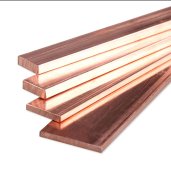tonyg
New Member
- Joined
- Apr 5, 2022
- Messages
- 136
Hi!
I've found various info on Google searches but wondering what would be the right way to size my busbar.
For wires, I can look in the table of the providers for the wires I buy. They have an amp specification in accordance to their size.
But with a bare copper tape / bar this information is not easily found and often contradictory numbers are found on different websites.
Should I simply do width X thickness and then look at the ampacity of same sized wires?
Cheers,
Tony

I've found various info on Google searches but wondering what would be the right way to size my busbar.
For wires, I can look in the table of the providers for the wires I buy. They have an amp specification in accordance to their size.
But with a bare copper tape / bar this information is not easily found and often contradictory numbers are found on different websites.
Should I simply do width X thickness and then look at the ampacity of same sized wires?
Cheers,
Tony



